With the increasing use of statistics in player recruitment, mainly being used as a complement to video analysis (the eye test), I felt it would be a good time to highlight the English Football League strikers that have statistically begun the 2020/21 season impressively, with the January transfer window just under two months away.
This data analysis will use statistics to spot strong performing strikers in the Championship, League One and League Two, some of these may not be spotted by video analysis, it is also worth noting that some players may not be spotted in this data analysis, that would be in a video analysis.
Methodology
I had to take into account the fact that it is still early on in the season, players who would be highlighted in a data analysis at the end of the season may not feature in this analysis due to a number of reasons, including them not breaking through into the first team yet or being injured. Players that have played at least 25% of their teams minutes this season will be included, some teams have played considerably less games than others due to their games being postponed as a consequence of COVID-19.
The metrics used may be slightly different compared to those used in an end of season player data analysis, which will be explained as I go through each section.
This isn’t a recruitment data analysis so the metrics used will be general for a striker with a high weighting towards final third output, particularly looking at the strikers’ goalscoring ability, although, as we know, the modern day forward is expected to do more than just score so other traits will also be analysed.
I hope this data analysis can provide a good insight into which players are worth noting as the season unravels, using statistics for a low number of games can provide little conclusion but the main purpose of this is to highlight strikers who have started well and who to look out for.
Goal scoring ability
This section will analyse the statistics which indicate a strikers’ ability to score goals and be able to finish and take their chances effectively, something that is key for sides looking to sign players in the EFL, such as West Brom or Aston Villa, who have signed strong performers from the Championship last season in Karlan Ahearne-Grant and Ollie Watkins.

The first graph takes a look at goals scored vs. minutes played, rather than goals per 90 as the season is still early and players that have played limited minutes may have done well in only one game, therefore, their statistics could be more flattening than they should be. The longer the season the goes on, the better conclusions we can make about a players’ current ability. Further graphs look more at a players’ finishing ability and their ability to score goals from a limited number of chances.
Ivan Toney has adapted impressively to the Championship, he is currently in a good vein of form having scored three goals in his last four games, Brentford’s ability to sign underrated players and sell them for a significant profit is admired by many and Toney is likely to be one of the next Brentford players targeted by Premier League clubs.
Armstrong has scored 11 goals in 10 games this season and spearheads a Blackburn side who look very good on paper, with the addition of Liverpool winger Harvey Elliott on loan.
Mullin is another player to watch out for in League Two, his Cambridge side are currently sitting second and his 11 goals this season have been key with just under 50% of their goals in the league coming from him.
In terms of players doing well having played under an average number of minutes, 21-year old Max Watters has done really well having signed from Doncaster Rovers in the summer, he was a late addition to the team hence his limited minutes but has scored six goals in seven games since joining.
Luke Jephcott also deserves a mention, he is 20-years old and has done well at Plymouth since being out on loan last season. He doesn’t finish many games but has still been able to get on the scoresheet four times in seven games, he scored a brace in his last match, against Swindon Town.

Mark Cullen and Ryan Taylor have the best goal conversion rates, Cullen has a goal conversion rate of 66.67%, though, he only takes 0.95 shots per 90. Cullen and Taylor have played four games apiece this season, we will have to wait for the season to evolve to see if they can sustain such high efficiency. Taylor performed well in League Two last season for previous club Plymouth and is a good addition to top of the league Newport County.
Most of those that rated highly in the previous graph have strong goal conversion rates compared to their peers given the number of shots they have.
Armstrong has a goal conversion rate of 21.15%, Blackburn have created 20 big chances this season, the most in the Championship which has led to Armstrong taking 5.06 shots per 90. It will be interesting to see how he fares if their creativity fizzles out and he is left to take his chances from a lower number of shots. In comparison, Toney has a goal conversion rate of 40%.

As expected, those that have performed well so far also perform well here and backs the idea that they’re good goal scorers. League Two trio Jack Muldoon, Joe Ironside and Jevani Brown have all scored seven goals so far this season, they scored more goals than expected having all been expected to score 3.7 goals this season. Muldoon’s rise to the EFL is inspiring, as his Harrogate Town side have taken League Two to storm.
Ability to aid transitions and create chances
This section looks more at the strikers’ assists and their ability to retain possession in the final third to help their sides’ transitions towards creating a chance.
It is worth noting that pass accuracy in the final third has a limitation as creative passes may not be so successful due to the difficulty of them and strikers are likely to be under great pressure in the opposition’s final third, compared to if they have possession in the deeper thirds.

Bright forward Tyrese Campbell has the most assists this season, at five, it is impressive given he played an average number of minutes yet still made the most assists, he has been deployed as a wide forward in a Stoke City team that have usually played 3-4-3 or a 3-4-3 variation. Note, at times has played in a centre forward position hence why he is in the database.
Bristol City duo Chris Martin and Antoine Semenyo have produced seven goals between them and their ability to create opportunities for teammates has helped Bristol City currently sit 5th in the league, two points off of the top.
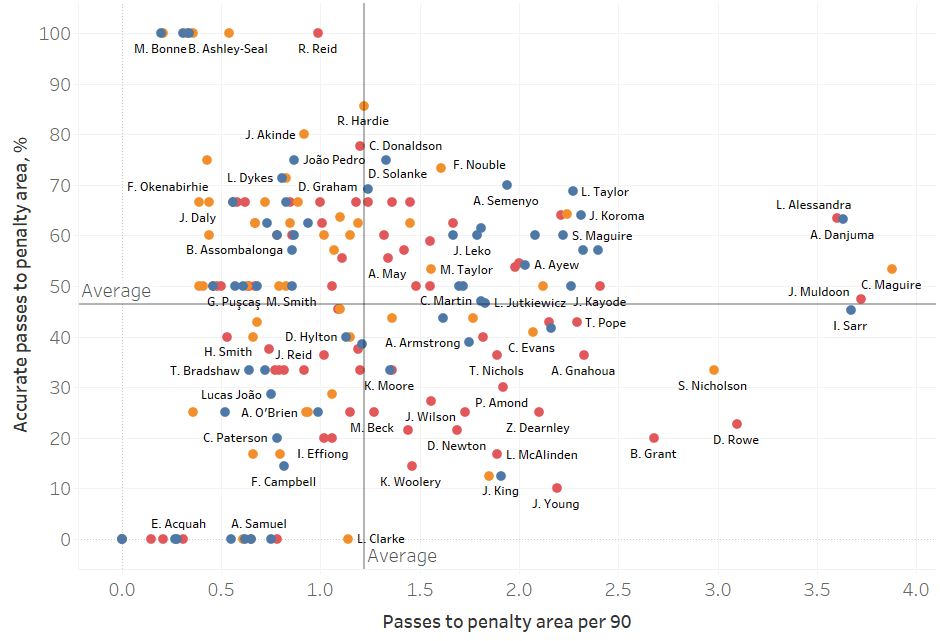
Given the number of passes to the area per 90, Arnaut Danjuma and Lewis Alessandra rank highly, in each match they provide the most passes to the penalty area with 2.30 and 2.28 respectively, closely followed by Chris Maguire at 2.07. Danjuma has been a key player for Jason Tindale this season, Danjuma and Maguire have usually been deployed out wide but the database includes players that have played striker this season, even in a limited number of games, to generate more knowledge.
Muldoon and Ismaïla Sarr lead the rest of the pack in terms of number of successful passes to the penalty area at 1.77 and 1.66 respectively per 90. Others with a high percentage given a decent number of passes to the penalty area include Lyle Taylor, Clayton Donaldson, Frank Nouble and Ryan Hardie who have all made at least 8 appearances this season.
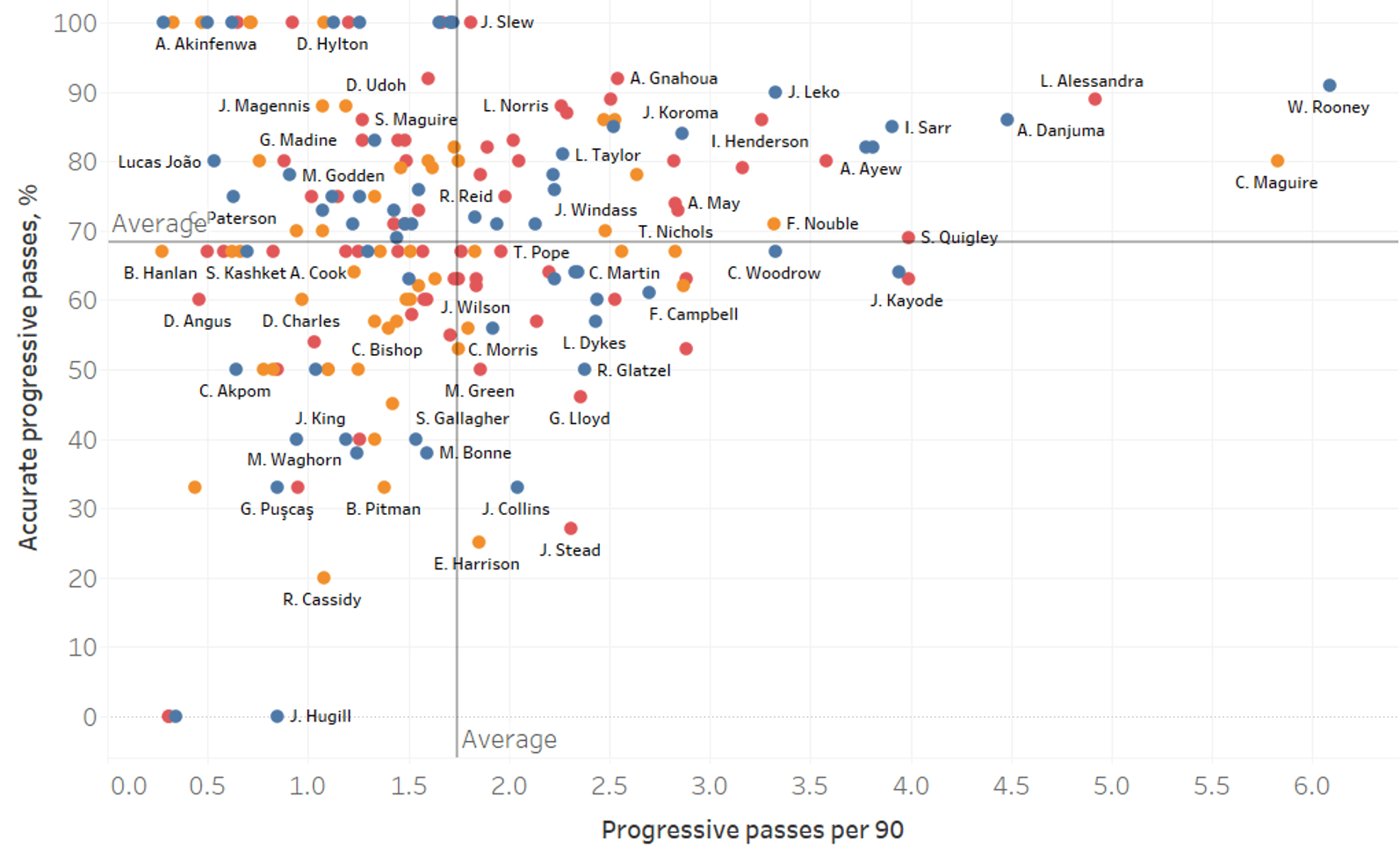
Those that rated well previously also rate well here, with Maguire making the second most successful progressive passes per 90 at 4.66, while ex-England international Wayne Rooney makes an impressive 5.54 successful progressive passes per 90.
As Rooney has grown in experience, he has more of his matches in deeper roles, due to his strength in range of passing and vision, aiding him in making these progressive passes. He has played as a striker three times this season, now he is part of the temporary team of coaches replacing Phillip Cocu, it will be interesting to see where he plays if he does play.
Progressive passes are defined as, in the opposition half, where the ball travels forward at least 10 metres from the starting position. It is likely the majority of the strikers’ passes will be in the opposition half.
Travelling with the ball
Next, I will take a look at the strikers’ threat when travelling with the ball.
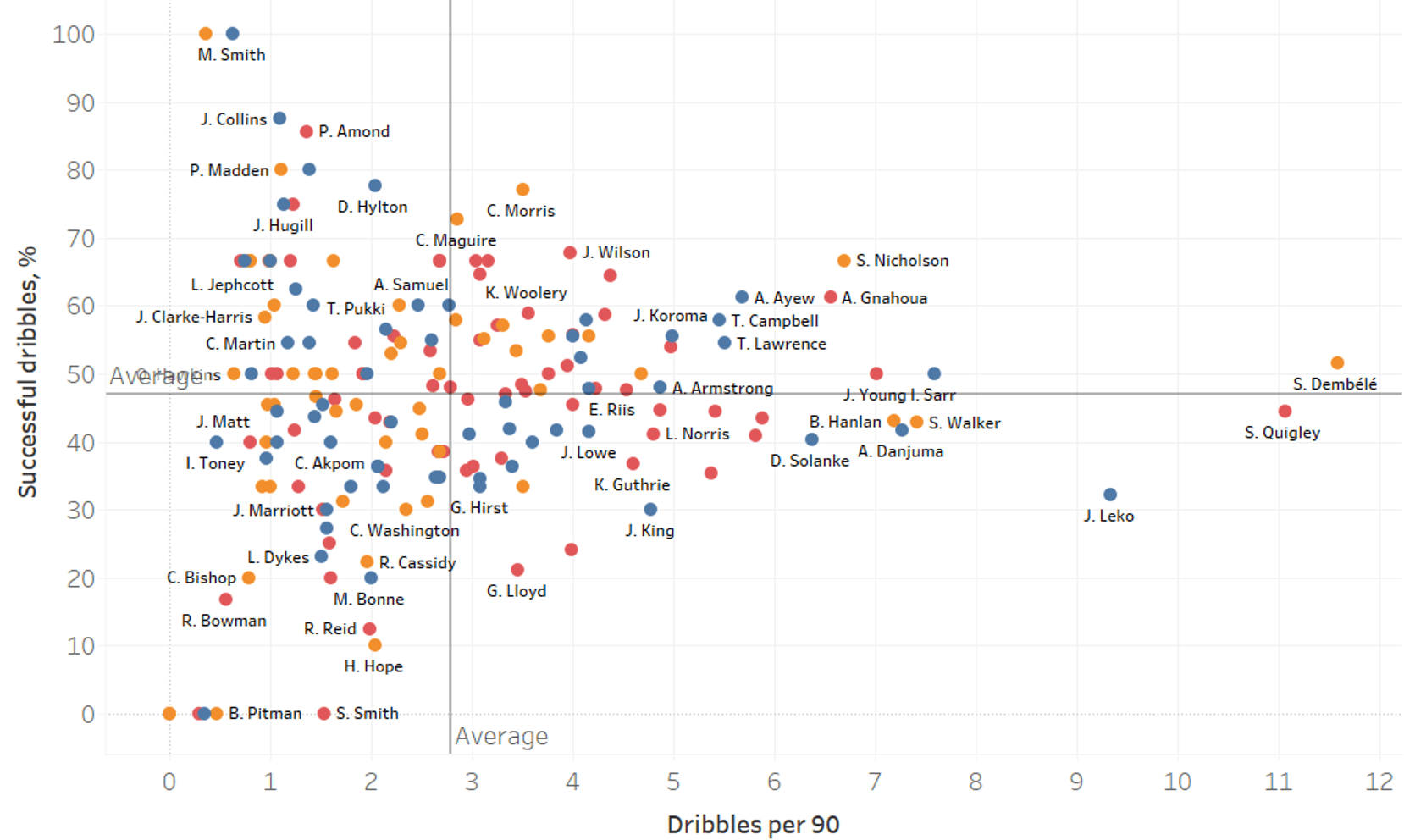
Scott Quigley and Jonathan Leko have played less than 300 minutes this season so will have to see how they fare with more minutes. With the loss of Toney to Brentford, Siriki Dembélé has had to step up after a good campaign last season, his main strength is in dribbling, having made 5.98 successful dribbles per 90, this has been key to producing opportunities for himself to score five goals this season.
The best of the rest who played an above-average number of matches include Scott Nicholson, Andre Ayew and Carlton Morris who were among those that made the most successful dribbles per 90. The best out of these is Nicholson who made 4.46 successful dribbles per 90, who will look to help new manager Paul Tisdale in pushing for promotion.
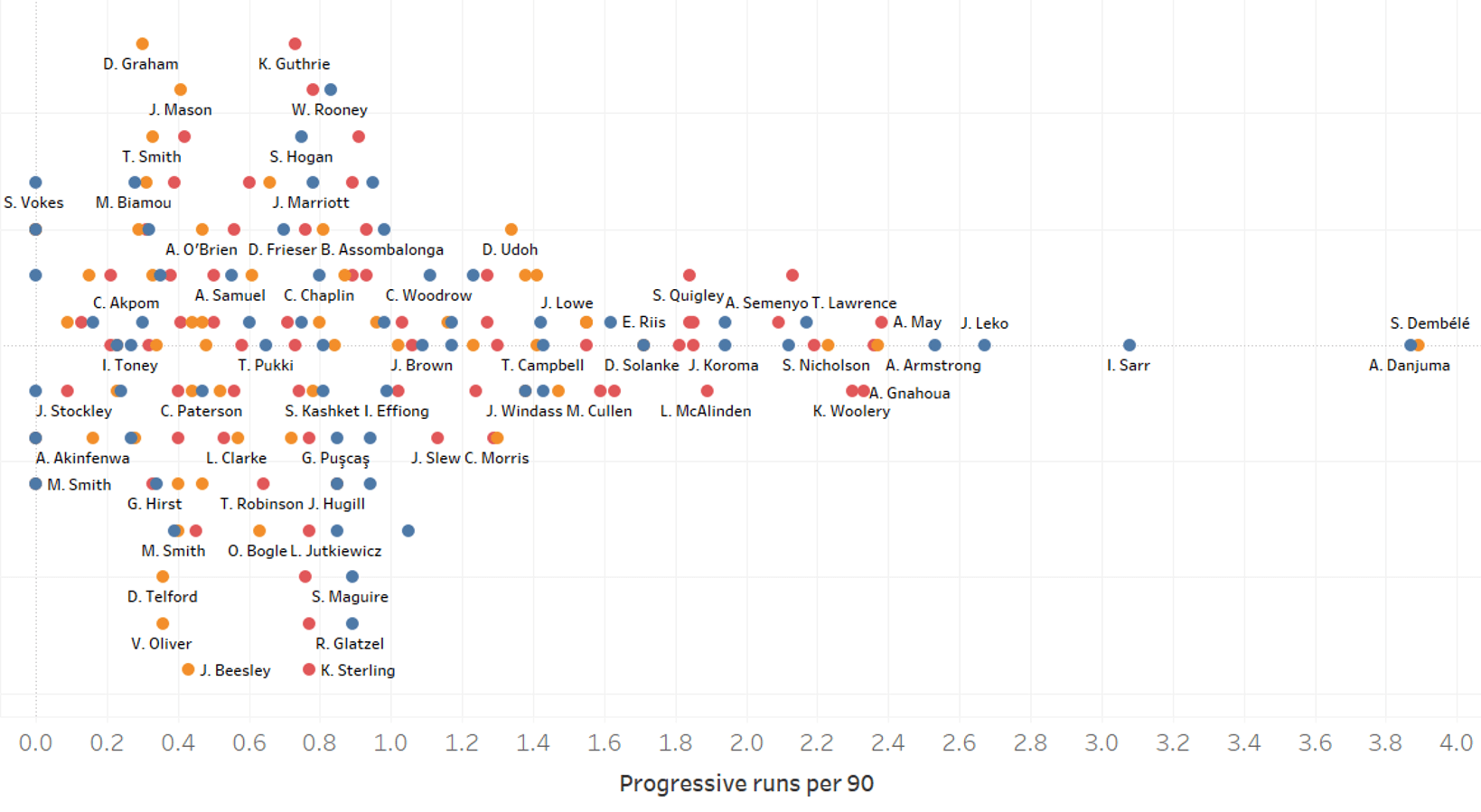
The definition for a progressive run is the same as that for a progressive pass, but instead of pass, it is a dribble. The best three progressive runners are Sarr, Dembélé and Danjuma; to those that have watched the EFL this season, it comes at no surprise that they rank highly with his metric, given that they are the most threatening players for their team when they dribble with the ball.
Dembélé and Danjuma lead having made 3.89 and 3.87 progressive runs per 90. Players that have done well in this and in earlier metrics include Armstrong and Nicholson.
Other interesting metrics
The final section before the shortlist is made, this section is just out of curiosity looking at different metrics to provide more insight into EFL strikers, so it will be a much shorter version than the others.
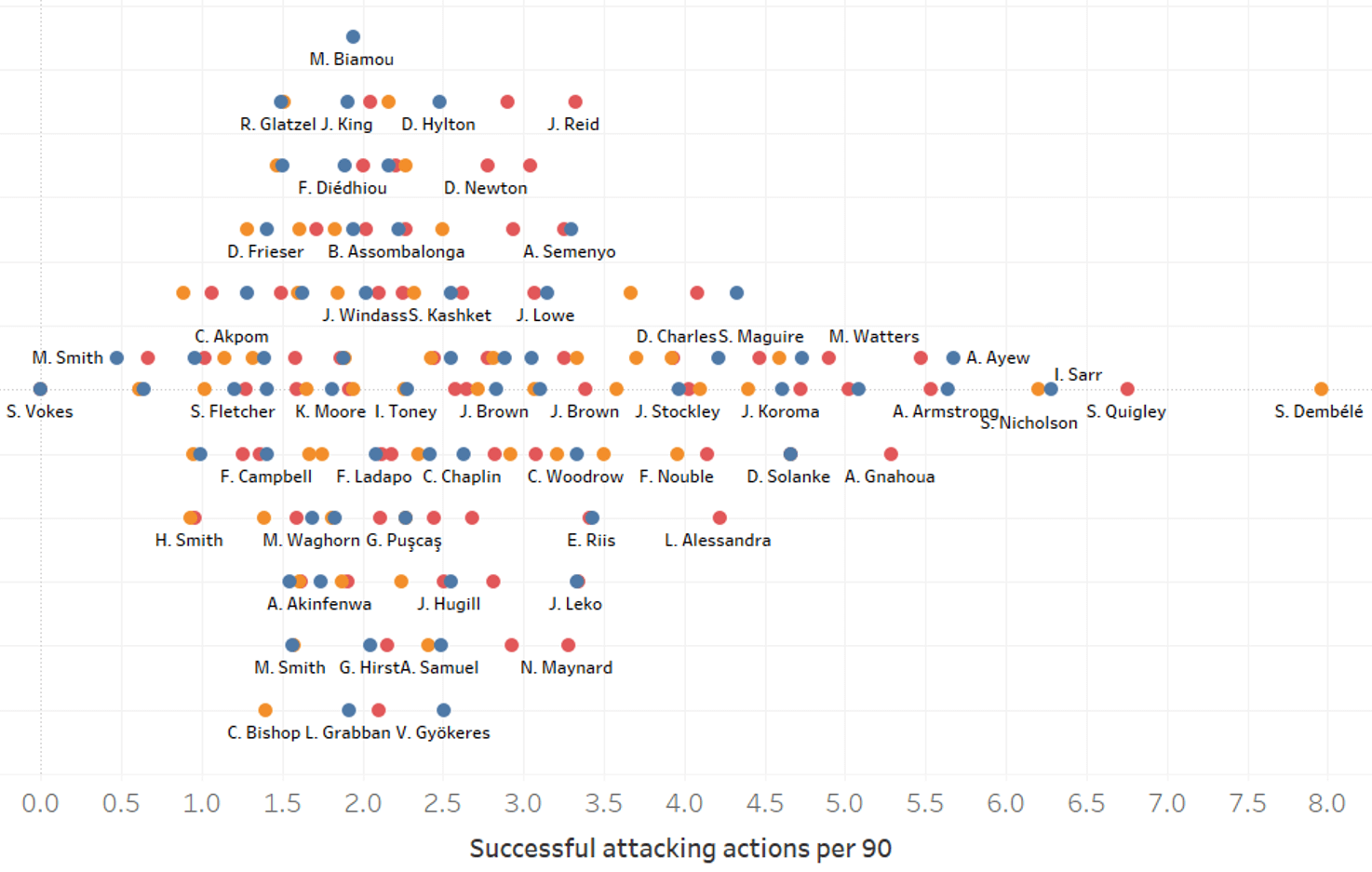
This graph tells us how active the strikers are in terms of attacking actions. From the graph, those that have been previously mentioned, rank highly here. Dembélé again ranks highly here, likely due to the number of dribbles that he made per 90, others close to him include Sarr, Nicholson, Ayew and Armstrong.
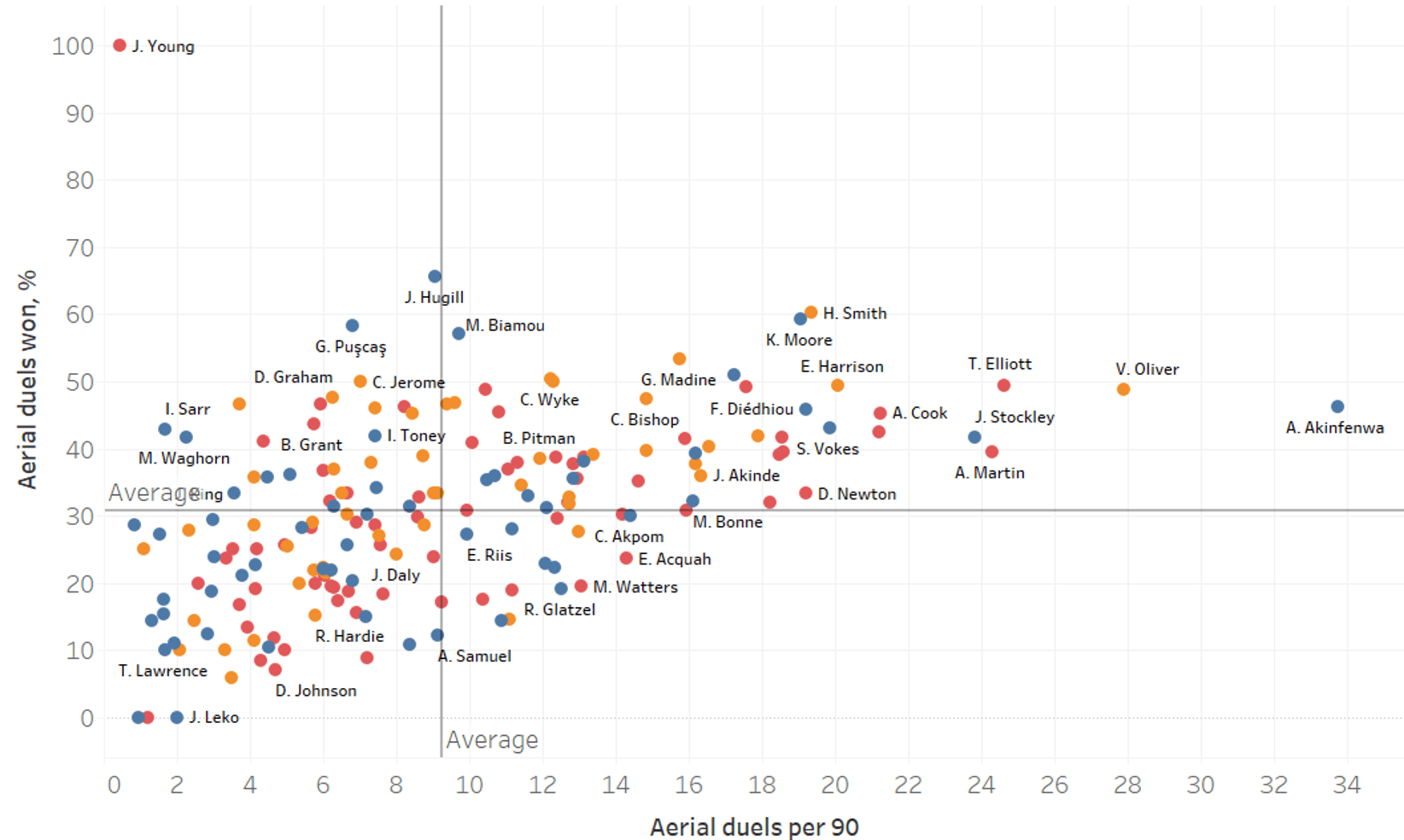
‘The beast’, Adebayo Akinfenwa is known for his strength and this helps him in holding defenders off from beating him in aerial duels, he has won 46.32% of his aerial duels so far this season, as he made 15.62 aerial wins per 90.
The best of the rest are Vadaine Oliver, Harry Smith, Tom Elliott and Kieffer Moore. All of these strikers are tall and strong so they are able to win their fair share of aerial duels. Moore is Cardiff’s main target man and is also a Welsh international.
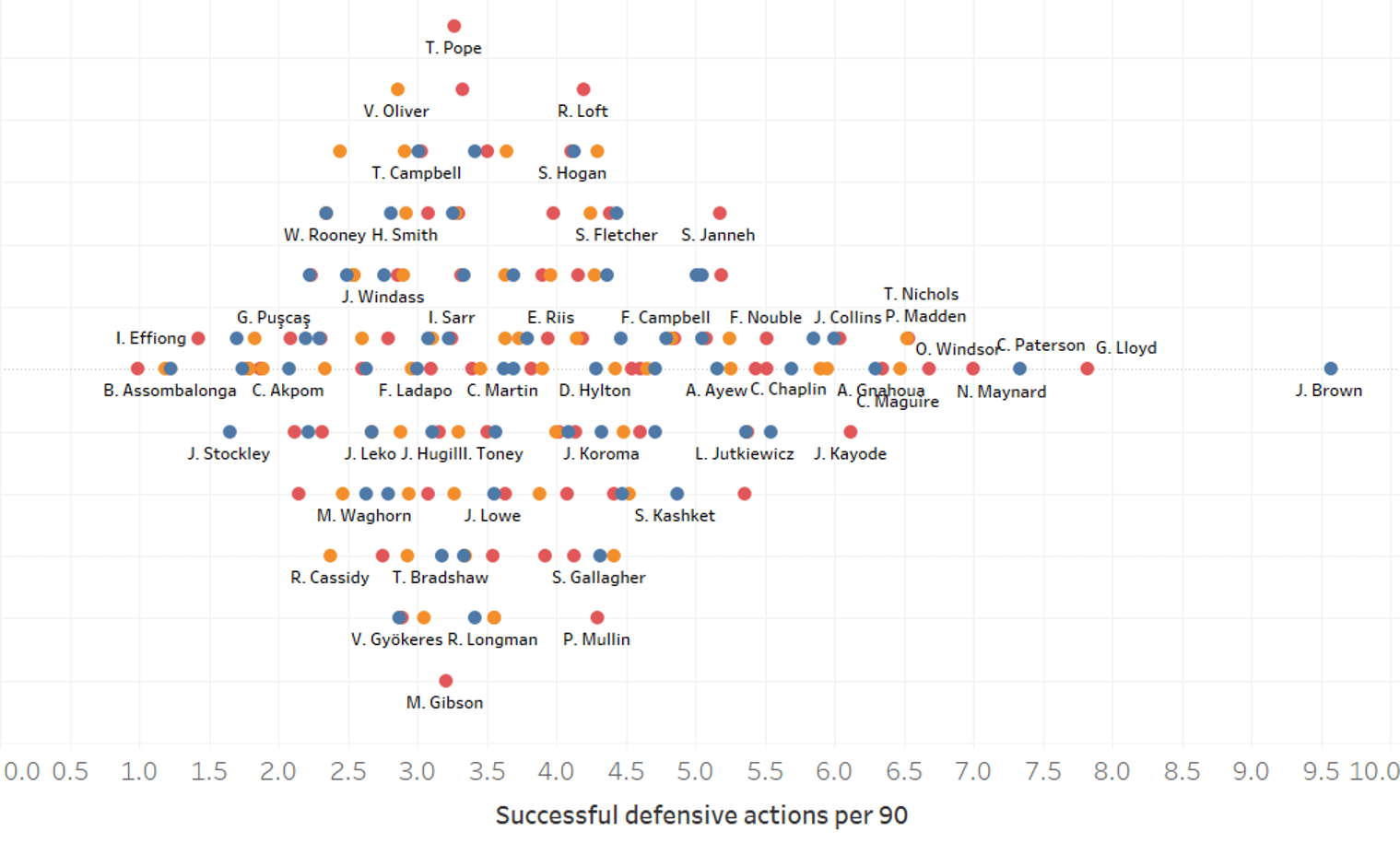
The final graph takes a look at the strikers’ defensive actions, this an indication that they are able to play the defensive forward role due to their high activity in making defensive actions but also tells us about their teams’ style of play. Jacob Brown has been a mainstay in the Stoke City front three this season and made 9.57 successful defensive actions per 90 last season, Michael O’Neill will be hoping the mix of experience and youth in his team can help their promotion push.
George Lloyd, Calum Paterson and Nicky Maynard rank behind Brown. None of these players have been mentioned as of yet and it is interesting to provide a general insight into players’ style.
Conclusion
I hope that this data analysis has provided readers with a greater insight into who in the EFL has started the first quarter of the season well. To conclude:
In the Championship, Ivan Toney and Adam Armstrong have been much in form and Toney’s goal conversion rate is particularly impressive. It will be interesting to see if they can sustain their goal output over a long Championship season which could see them targeted by sides of Europe’s top leagues if their sides don’t get promoted. Young players Arnaut Danjuma, Tyrese Campbell and Antoine Semenyo are also worth watching out for.
Peterborough’s Siriki Dembélé looks a threatening and dangerous dribbler and has been linked with a move to Newcastle United if keeps up his form it will come at no surprise if he leaves to a higher division. Another who impressed was Plymouth’s Luke Jephcott, it is Plymouth’s first season back in League One but it could aid his progression as he is still only young.
Finally, in League Two, the most impressive players were Jack Muldoon, Paul Mullin and Max Watters. This could be Mullin’s breakout season and is currently in the form of his life. Muldoon is another striker that has come from the National League and taken the EFL by storm, Harrogate are defying expectations and he will be key to them defying the odds this season. Watters has the best goals per 90 ratio out of everyone, having averaged 1.09 goals per 90 while playing 496 minutes, he is another player who is worth watching to see if he can sustain his impressive statistics.





Comments